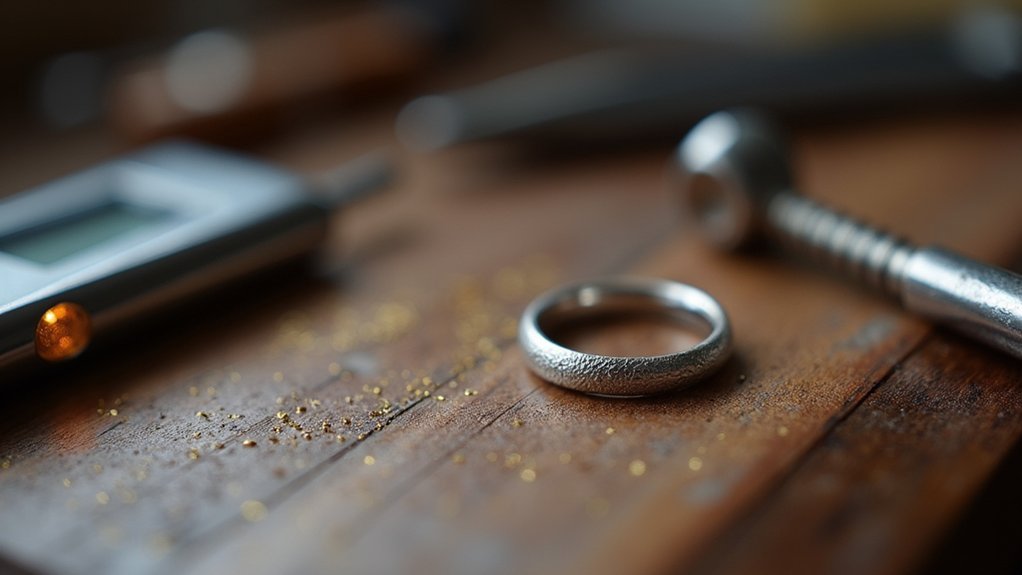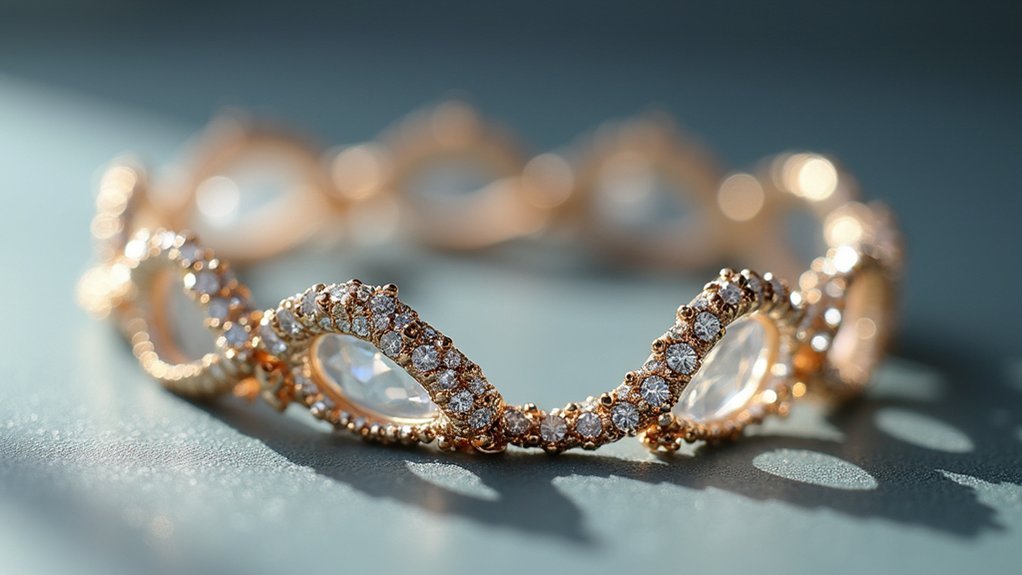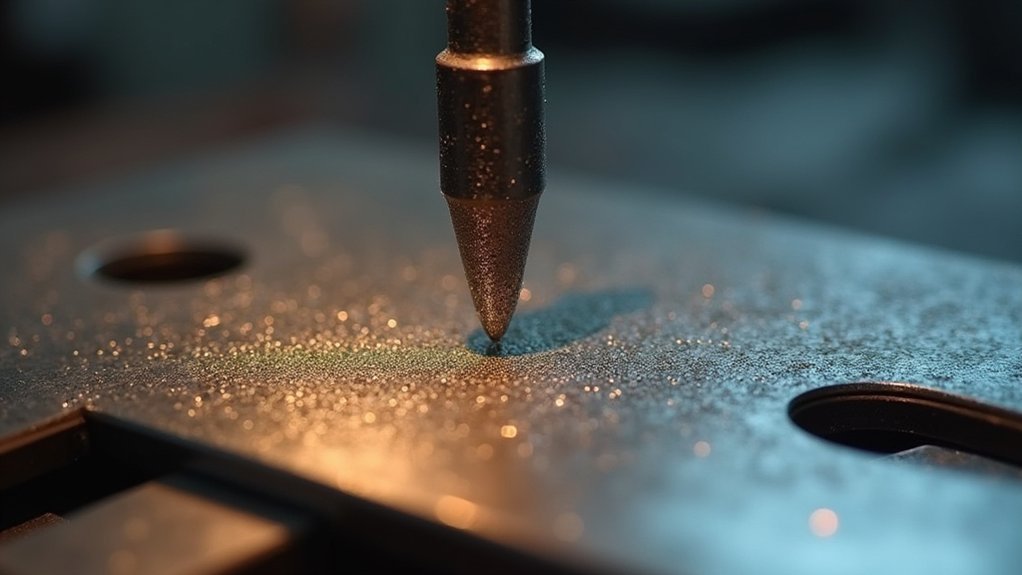Fine metal soldering precision matters because you’ll permanently damage expensive gemstones and create weak joints that fail within months without proper temperature control between 600°F to 700°F. You need precise surface preparation, proper flux application, and controlled gaps to achieve seamless joints that maintain 70% of your parent metal’s strength. Poor technique results in thermal stress, oxidation, and visual flaws that compromise your jewelry’s integrity and drastically reduce its lifespan, but mastering these fundamentals reveals professional-grade results.
The Critical Role of Temperature Control in Fine Jewelry Soldering

When working with precious metals and delicate gemstones, you’ll find that temperature control becomes the cornerstone of successful fine jewelry soldering. You must maintain soldering temperature between 600°F to 700°F (316°C to 371°C) to prevent overheating that can damage sensitive materials and alter metal properties.
Using adjustable temperature soldering irons lets you tailor heat application for different materials, preventing thermal shock and warping. You should apply heat directly to joint areas, enabling quicker solder flow while protecting surrounding materials from unnecessary exposure.
Careful monitoring guarantees both solder and base metals reach appropriate temperatures without excess heat. This consistent temperature management creates strong, reliable joints that preserve your jewelry’s structural integrity and aesthetic quality.
Achieving Seamless Joints Without Visible Solder Lines
You’ll need to master surface preparation techniques to create flawless solder joints that blend invisibly with your metal.
Proper cleaning removes oxidation and contaminants that can cause visible solder lines to form along joint boundaries.
Temperature control methods work hand-in-hand with surface prep to guarantee your solder flows smoothly without leaving telltale marks.
Surface Preparation Techniques
Three critical factors determine whether your soldered joint will achieve professional invisibility: surface cleanliness, proper flux application, and precise gap control.
You’ll need absolutely clean surfaces since contaminants prevent proper adhesion and create weak solder joints. Don’t worry about polishing everything to a mirror finish – rough surfaces often provide sufficient bonding without extensive preparation.
Apply adequate flux like Borax to guarantee ideal filler metal flow and enhance bonding quality.
You’ll achieve the best results by controlling gaps precisely during clamping. Use gage blocks and feeler gauges to measure and maintain consistent spacing.
Remember that interface geometry can change over time, so careful surface preparation isn’t just about immediate results – it’s essential for maintaining long-term joint integrity and performance.
Temperature Control Methods
How can you achieve those coveted invisible solder lines that separate amateur work from professional craftsmanship? Master temperature control methods by maintaining your soldering iron between 600-700°F (316-371°C). This precise range guarantees ideal melting without damaging sensitive components.
You’ll need fine-tipped soldering irons for accurate heat application to specific areas, preventing excessive spillage. Implement heat sink techniques to control heat distribution while making sure solder reaches proper liquidus temperature. This prevents overheating adjacent components.
Don’t overlook flux’s critical role in your temperature control methods—it removes oxides and enhances flow, eliminating cold solder joints that create visible lines.
Regular equipment calibration and maintenance of temperature measurement devices guarantees consistent heat application, preventing variations that cause visible solder lines or joint failures.
Preventing Heat Damage to Precious Stones and Delicate Settings

When working with precious stones and delicate settings, you’ll need to master temperature control since excessive heat can permanently damage gemstones or warp intricate metalwork. Opals and pearls are especially vulnerable to thermal stress, which can cause discoloration, cracking, or complete destruction.
You should maintain soldering temperatures between 600-700°F to stay within safe thermal limits for both metals and stones. Use fine-tipped soldering irons to apply heat selectively, minimizing exposure to surrounding materials. This targeted approach protects delicate settings made from softer metals that deform under high temperatures.
Proper surface preparation and flux application help you achieve strong bonds at lower temperatures, providing an additional safeguard. These precise techniques guarantee you’ll preserve the integrity and beauty of intricate jewelry pieces.
Material Compatibility Considerations for Different Metal Types
Metal compatibility becomes your primary concern once you’ve mastered temperature control, as different metals present unique challenges that can make or break your soldering success.
You’ll need to match thermal expansion rates to prevent stress cracking, select appropriate fluxes to combat surface oxides, and choose the right solder alloy for each metal combination.
Consider these critical compatibility factors:
- Melting point alignment – Confirm your solder alloy melts at a lower temperature than both base metals to avoid component damage.
- Oxide formation resistance – Select fluxes that effectively clean specific metal surfaces, especially for aluminum or titanium work.
- Mechanical property matching – Align your solder’s tensile strength and ductility with the base metals’ characteristics for peak joint performance.
Joint Strength Requirements for Wearable Jewelry Pieces

When you’re creating wearable jewelry, you’ll need to understand how forces distribute across your solder joints during normal wear and movement.
You must conduct fatigue resistance testing to guarantee your joints won’t fail after thousands of daily stress cycles from bending, twisting, and impact.
Your soldered connections require specific strength parameters to withstand years of continuous wear without compromising the piece’s structural integrity.
Stress Distribution Analysis
Since wearable jewelry experiences constant movement and pressure throughout daily wear, you’ll need to analyze stress distribution patterns to confirm your soldered joints won’t fail prematurely.
Uneven stress concentrates at weak points, causing fatigue and cracking that compromises your piece’s integrity. When you apply precision soldering techniques with a quality soldering iron, the solder flows evenly into joints, distributing stress more effectively.
Proper stress distribution analysis involves:
- Identifying high-stress zones where joints experience the most tension and movement during regular wear
- Selecting appropriate solder alloys with superior mechanical properties that resist wear better than standard solders
- Conducting tensile strength testing on completed joints to validate your design meets durability requirements
This analysis confirms your jewelry withstands everyday demands without structural failure.
Fatigue Resistance Testing
High-wear areas like clasps, hinges, and connection points face the greatest stress during testing.
You’ll need proper soldering techniques and high-purity alloys to boost fatigue resistance and reduce crack formation.
For intricate jewelry designs with complex joints, you must employ specialized soldering practices to meet rigorous fatigue standards.
This testing guarantees your pieces maintain structural integrity throughout their expected lifespan, preventing costly failures and maintaining customer satisfaction.
Daily Wear Durability
Jewelry pieces face relentless mechanical stress during everyday wear, demanding solder joints that match or exceed the strength characteristics of their base metals. Your daily wear rings and bracelets endure constant tensile and shear forces that can compromise poorly executed joints.
Quality solder wire must achieve at least 70% of the parent metal’s strength to guarantee peak durability.
Critical factors for maximizing joint longevity include:
- Proper surface preparation – Clean, oxide-free surfaces create stronger bonds
- Ideal solder wire thickness – Appropriate filler material volume prevents weak spots
- Precise heating control – Consistent temperature prevents overheating damage
You’ll find that clasps and moving components require especially robust joints to resist fatigue.
Regular maintenance of polished, clean joints greatly reduces corrosion and extends your jewelry’s lifespan.
Surface Preparation Techniques for Clean Metal Bonding

When you’re preparing metal surfaces for soldering, the cleanliness of your workpiece determines whether you’ll achieve a strong, reliable joint or face frustrating failures. Contaminants disrupt adhesion and create weak points that’ll compromise your work’s integrity.
| Surface Condition | Preparation Method | Joint Quality |
|---|---|---|
| Oxidized copper | Fine abrasive cleaning | Excellent flow |
| Greasy steel | Degreasing solvent | Strong bond |
| Painted aluminum | Chemical stripping | Clean interface |
| Tarnished silver | Polishing compound | ideal wetting |
| Rough brass | Light sanding | Enhanced contact |
You’ll need proper flux like Borax to reduce surface tension and promote filler metal flow. Clean, smooth interfaces facilitate atomic diffusion, while controlled clamping pressure maintains ideal gaps. Whether you’re working with polished or scuffed finishes, thorough preparation guarantees your solder flows correctly and creates durable connections.
Tool Selection for Precision Work on Small Components
Your soldering iron becomes the most important factor in achieving precision on small components.
Your soldering iron determines whether you achieve clean, precise joints or damage delicate components on your circuit board.
You’ll need adjustable temperature settings to prevent damage to sensitive electronic parts while maintaining proper heat control. Tapered tips focus heat exactly where you need it, ensuring accurate solder application without affecting nearby components.
For ideal precision soldering results, consider these essential tools:
- Fine diameter solder wire – Enables precise application in tight spaces while minimizing spillage that could bridge connections.
- Ergonomic soldering tools – Reduces hand fatigue and improves control, directly impacting joint quality on delicate work.
- Magnification equipment – Microscopes or magnifying lamps help you inspect joints closely, ensuring your work meets high precision standards.
These tools work together to elevate your soldering accuracy considerably.
Common Precision Errors That Compromise Jewelry Integrity

Although precision tools set the foundation for quality work, even experienced craftspeople can fall into habits that undermine their jewelry’s structural integrity.
You’ll compromise joint strength when you apply excessive heat, creating thermal stress that weakens metals and leads to eventual failure. Skipping proper surface cleaning allows oxidation to prevent adequate solder adhesion, resulting in weak connections that break under pressure.
Poor alignment creates uneven joints with both visual flaws and structural vulnerabilities. When you don’t apply sufficient flux, solder won’t flow properly, compromising coverage and durability.
Conversely, using too much solder creates bulging joints that concentrate stress points and detract from your piece’s aesthetic appeal while increasing mechanical failure risk.
Quality Control Methods for Professional Jewelry Standards
Professional jewelry standards demand systematic quality control methods that go beyond visual inspection to secure structural integrity.
Quality control in professional jewelry requires systematic testing protocols that extend far beyond basic visual examination to ensure lasting structural reliability.
You’ll need rigorous testing protocols that evaluate solder joints for strength, durability, and proper fillet heights while identifying voids that compromise connections.
Your quality control process should include:
- Magnification Assessment – Use specialized tools to detect visual defects like excessive oxidation or poor flow patterns that indicate temperature control issues.
- Alloy Composition Verification – Confirm high purity standards and proper melting point compatibility to prevent contamination and joint failure.
- Tensile Strength Testing – Implement standardized protocols that measure actual joint performance against industry benchmarks.
Regular skill assessments for your team emphasize precise temperature control and proper soldering techniques.
You’ll maintain consistent quality by adhering to these systematic inspection methods.
Advanced Techniques for Complex Multi-Metal Assemblies
Complex multi-metal assemblies present unique challenges that require specialized approaches beyond standard single-metal soldering techniques.
You’ll need tailored solder alloys that effectively bond dissimilar metals while maintaining joint integrity under thermal stress. Precise temperature control becomes critical to prevent component damage and achieve ideal solder wetting and flow.
Specialized flux formulations prevent oxidation and enhance adhesion during brazing and soldering processes, ensuring reliable connections throughout your assembly.
Consider implementing robotic soldering systems to improve accuracy and repeatability while reducing defect risks compared to manual methods.
High purity solder alloys are essential for minimizing contamination in your multi-metal joints.
These premium materials create strong, durable connections that withstand harsh operating conditions, making them indispensable for professional-grade assemblies requiring long-term reliability.
Frequently Asked Questions
What Is an Important Factor When Soldering?
You’ll find surface cleanliness is essential when soldering. Contaminants compromise joint integrity and electrical performance, so you must thoroughly clean all surfaces before applying solder to guarantee strong, reliable connections.
Why Is Knowing Soldering Activity Important?
You’ll prevent electrical failures and extend product lifespan by understanding soldering activity. It helps you control contamination, select proper materials, manage thermal conditions, and reduce manufacturing defects considerably.
Why Is a Soldering Station Considered Better Than a Soldering Iron?
You’ll get better temperature control and stability with a soldering station compared to a basic iron. It provides consistent heat, interchangeable tips, and convenient cleaning tools for more precise work.
Why Is Extra Solder Flux Sometimes Useful for Electrical Soldering?
You’ll find extra solder flux removes oxides and contaminants, improving heat transfer and solder flow. It prevents bridging defects, stops oxidation during heating, and can provide corrosion protection for longer-lasting joints.
In Summary
You’ll find that mastering fine metal soldering precision isn’t just about technique—it’s about protecting your investment and reputation. When you control every variable from temperature to joint placement, you’re ensuring your pieces won’t fail under daily wear. Don’t compromise on precision tools or quality control methods. Your clients expect jewelry that’ll last generations, and that’s only possible when you’ve perfected these critical soldering fundamentals.





Leave a Reply